Gagaku Instruments
In the Gagaku term, percussion instruments are called "Uchimono, tapping instrument", string instruments "Hikimono, pulling instrument" and wind instruments "Fukimono, blowing instrument".
The “Kangen” which is the oldest form of the orchestra in the world, is composed of a total of 16 people: three people for each of three wind instruments, one person for each of two string instruments and one person for each of three percussion instruments.
By the positioning of the instruments, the percussion instruments are placed in the first row, the stringed instruments in the middle row and the stringed instruments in the last row.
The List of Instruments
| (1) Uchimono |
(2) Hikimono |
(3) Fukimono |
| ① Kakko |
① Biwa |
① Sho |
| ② Taiko |
② So |
② Hichiriki |
| ③ Shoko |
③ Wagon |
③ Ryuteki |
| ④ San-no-Tudumi |
|
④ Komabue |
| ⑤ Dadaiko |
|
⑤ Kagurabue |
| ⑥ Daishoko |
|
|
| ⑦ Shaku-Byoshi |
|
|
(1) Uchimono, percussion instruments
① Kakko (barrel drum)
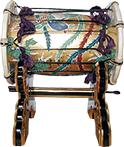 The Kakko plays the role of conductor. In Gagaku, there is no leader like in Western music. It is the Kakko player who takes on this role. In most cases, it is the veteran who knows Gagaku best who plays Kakko.
The Kakko plays the role of conductor. In Gagaku, there is no leader like in Western music. It is the Kakko player who takes on this role. In most cases, it is the veteran who knows Gagaku best who plays Kakko.
It gives a sign at the beginning or end of the pieces and controls the total movement of the music by arranging the tempo, etc.
He carries two "Bashi" sticks with his left and right hands and strikes two sides of the instrument as if describing a circle. We call “scratching” the act of playing the Kakko.
② Taiko (large drum)
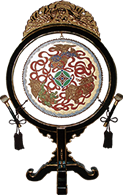 The Taiko is called the Tsuri-daiko or the Gaku-daiko. The pinned drum is fixed inside a round wooden frame by the three sides by means of ropes. Taking two mallets in both hands, the end of which is large and round, wrapped in deer skin, the player strikes on one side only.
The Taiko is called the Tsuri-daiko or the Gaku-daiko. The pinned drum is fixed inside a round wooden frame by the three sides by means of ropes. Taking two mallets in both hands, the end of which is large and round, wrapped in deer skin, the player strikes on one side only.
Hitting lightly with the left hand is called "Zou-n", and hitting hard with the right hand is called "Dô". The left mallet is hit first, then the right mallet. This way of hitting "Awase-bachi, combination of mallets" is a fundamental method for hitting Taiko.
③ Shoko (gong)
 It is the only instrument made of metal in Gagaku. A form of copper plate is fixed by the three sides by means of cords inside a round wooden frame. The player plays this instrument by holding the lower ends of two mallets. We don't say "hit" but "drag" to play Shôko. There are two ways of dragging: dragging with a single mallet or two mallets at the same time. When dragging with two mallets, one first drags the left mallet faster than the other.
It is the only instrument made of metal in Gagaku. A form of copper plate is fixed by the three sides by means of cords inside a round wooden frame. The player plays this instrument by holding the lower ends of two mallets. We don't say "hit" but "drag" to play Shôko. There are two ways of dragging: dragging with a single mallet or two mallets at the same time. When dragging with two mallets, one first drags the left mallet faster than the other.
The Shoko adorns the sound of the Taiko or the Kakko in the orchestration with its high sonority characteristic of the metallic material. It is for this reason that the Shoko is often played as an accompaniment to the Taiko and struck slightly behind the Taiko.
④ San-no-tsuzumi(small drum)
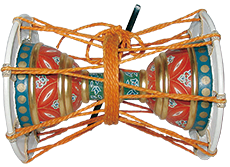 It is used when playing Komagaku, Korean music. The shape resembles the recumbent shape of an hourglass. Both sides of wooden tube are wrapped by framed skins. This instrument is tied with a cord called “Shirabeo”.
It is used when playing Komagaku, Korean music. The shape resembles the recumbent shape of an hourglass. Both sides of wooden tube are wrapped by framed skins. This instrument is tied with a cord called “Shirabeo”.
We tap two sides with the chopsticks carried by both hands for the Kakko, while for the San-no-tsutsumi, we only hit on the right with a chopstick.
⑤ Da-daiko (big drum) ⑥ Dai-shôko (large gong)
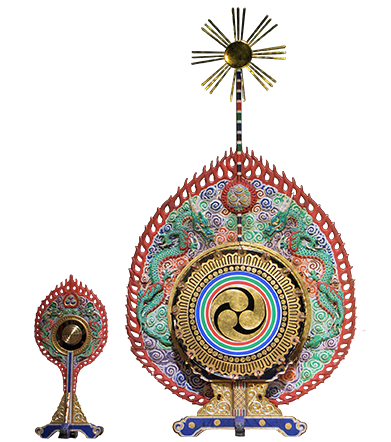 The Da-daiko is used during Bugaku (dance). A pair is placed on both sides, left and right, of the stage. Since Bugaku was originally played outdoors, such a large Da-daiko was more appropriate. As a flame-shaped decoration was placed around this Taiko, it was called "Kaen-da-daiko, the big flame drum".
The Da-daiko is used during Bugaku (dance). A pair is placed on both sides, left and right, of the stage. Since Bugaku was originally played outdoors, such a large Da-daiko was more appropriate. As a flame-shaped decoration was placed around this Taiko, it was called "Kaen-da-daiko, the big flame drum".
The dragon, the sun and the golden color are drawn on the left instrument, while on the right instrument the phoenix, the moon and the silver color are drawn. The first symbolizes Yang and the odd number, and the second symbolizes Yin and the even number.
⑦ Shaku-byoshi(wooden clapper)
 It is the simplest instrument among the Gagaku instruments. It resembles a vertically cut wooden scepter worn by nobles in the Heian period.
It is the simplest instrument among the Gagaku instruments. It resembles a vertically cut wooden scepter worn by nobles in the Heian period.
The left part is placed vertically with the cut side towards the player, while the right part is placed horizontally with the cut side to the left. It is by hitting these two parts that the sound is released. It is used for "Utai-mono" such as "Saibara" or "Kuniburi-no-utamai".
(2) Hikimono (string instruments)
① Biwa (lute)
 It is called "Gaku-biwa" to distinguish it from other different types of "Biwa". The origin of this instrument is in Persia, present-day Iran. It was brought to Japan by the Silk Road in the Nara period, around the 8th century. The instrument that was brought to Europe became the lute and today the guitar.
It is called "Gaku-biwa" to distinguish it from other different types of "Biwa". The origin of this instrument is in Persia, present-day Iran. It was brought to Japan by the Silk Road in the Nara period, around the 8th century. The instrument that was brought to Europe became the lute and today the guitar.
The Biwa for Gagaku is the biggest among all kinds of Biwa in Japan. The sound that comes out of this instrument made of chestnut or pear wood and which resonates thanks to the silk strings, is powerful enough despite the orchestration of Gagaku where instruments that produce a large volume of sound come together. In the piece, he plays the role of determining the head for the rhythm. It has four strings and four frets.
We wear it horizontally and we play with the plectrum. It is not to play a melody, but, it is basically played by the arpeggio method, so that several strings are sounded simultaneously, starting from the low note towards the high note.
② So (harp)
 To distinguish it from other Sô, it is called the "Gaku-Sô". It came from China at the time of Nara in the 8th century. As the Chinese harp has spread not only to Japan, but also to Korea, Mongolia or Indonesia, the same type of instrument can be seen in a vast region in eastern Asia.
To distinguish it from other Sô, it is called the "Gaku-Sô". It came from China at the time of Nara in the 8th century. As the Chinese harp has spread not only to Japan, but also to Korea, Mongolia or Indonesia, the same type of instrument can be seen in a vast region in eastern Asia.
The cords are thirteen in number and are produced in twisted silk. For tuning, the frets are introduced between the body of the instrument and each string.
When we play it, we put bamboo nails on the thumb, index and middle finger of the right hand. There are basically two ways to play depending on the mood of the songs: “Haya-gaki” which plays lightly and “Shizu-gaki” which plays slowly.
The Biwa is responsible for determining the head of each phrase, while the Sô is responsible for the tempo in each piece.
③ Wagon (japanese harp)
 It is a kind of Sô with six strings used to play songs and dance (Kuniburi-no-utamai) which has existed since the antiquity of Japan. Most of these instruments are made from paulownia.
It is a kind of Sô with six strings used to play songs and dance (Kuniburi-no-utamai) which has existed since the antiquity of Japan. Most of these instruments are made from paulownia.
The frets are made from maple branches. This instrument is played by carrying the plectrum produced from bekko (hawksbill turtle scales) with a length of about 7 cm in the right hand and also by the fingers of the left hand.
(3) Fukimono (wind instrument)
① Sho (small mouth organ)
 The shape of the Shô is very characteristic, being made up of an assembly of seventeen bamboo pipes placed vertically in a circle on a kind of black bowl called "Kashira, the head". It is said that this form was imitated in the image of a fenghuang, a legendary bird that rested its wings. This is why this instrument is also called "Hô-shô".
The shape of the Shô is very characteristic, being made up of an assembly of seventeen bamboo pipes placed vertically in a circle on a kind of black bowl called "Kashira, the head". It is said that this form was imitated in the image of a fenghuang, a legendary bird that rested its wings. This is why this instrument is also called "Hô-shô".
Among the seventeen bamboo pipes, the reeds are attached to fifteen pipes. By pressing on the small orifices below these pipes, sounds are produced by both exhalation and inspiration. This is why the sound is never interrupted during the performance. By pressing the six small holes with your fingers, the chord called "Aitake” is produced. The player heats the instrument on the stove before and after the performance so as not to leave the vapor produced by the inspiration inside the instrument.
The sound of Shô is expressed as "heavenly light". The characteristic of this sound is to give the impression on the expanse as if it encompasses the entirety of our universe. The sound of Shô is essential for the musical interval.
② Hishiriki (small double-reed instrument similar to oboe)
 It is an instrument that came from China at the time of the Tang Dynasty. Its origin is located in western Asia, corresponding to present-day Turkey and Iran.
It is an instrument that came from China at the time of the Tang Dynasty. Its origin is located in western Asia, corresponding to present-day Turkey and Iran.
The double reed (in English double reed) made from a reed stem is introduced into the piece of bamboo with a length of about 18 cm to give the sound. Although it has only one octave, it can be played in a specific and ornamental way by emphasizing the modulation of sounds which is called “en-bai”. The Hichiriki takes care of playing the melody and the main theme of the music with much more richness of volume than one imagines from the small size of this instrument.
If it is said that the Shô produces a celestial sound, the sound of the Hichiriki expresses the voice of man who lives on earth.
③ Ryuteki (kind of transverse flute)
④ Komabue
⑤ Kagurabue
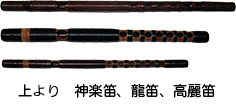 There are three kinds of transverse flute in Gagaku: the Ryûteki, the Koma-bue and the Kagura-bue. Among these three, it is only the Ryûteki which is used for the representation of the Kangen. It is also called "Omo-bue".
There are three kinds of transverse flute in Gagaku: the Ryûteki, the Koma-bue and the Kagura-bue. Among these three, it is only the Ryûteki which is used for the representation of the Kangen. It is also called "Omo-bue".
The range of sound is wider than the Hichiriki which takes care of the main melody. That is why he plays in an ornamental way.
For the men of the Heian period, the flute was a basic instrument for the knowledge of music. You can read about several good Pied Pipers in "The Tale of Genji".
Koma-bue is mainly used for Chinese Koma-gaku music, while Kagura-bue for Japanese Kuniburi-no-utamai music.
It is said that if the Ryuteki is written "the flute of the dragon", it is because the sound of the Ryuteki resembles the cry of the dragon ("ryû") which flies away in space.
We have just explained the wind instruments. These three wind instruments are usually played by three players for each of these instruments and to play the repertoire melody and harmony.
The Shô symbolizes the way coming from the sky where the fenghuang lives, the Hichiriki expresses that coming from the earth where the man lives, and finally the Ryûteki that of the dragon which moves freely between the sky and the earth. The concert expressed by these three instruments thus forms the microcosm.

